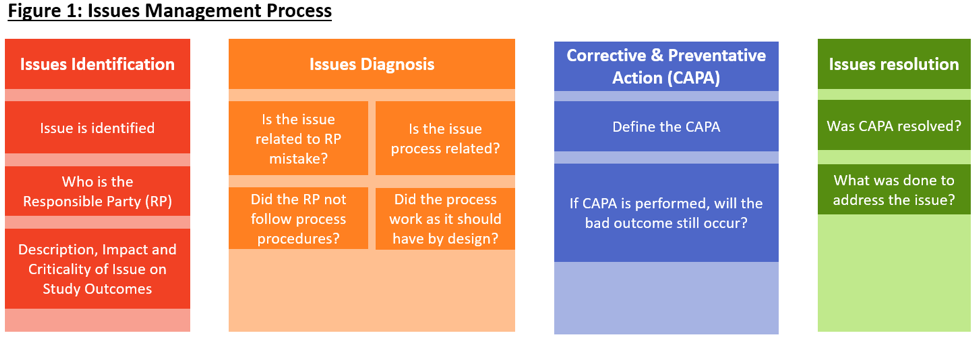Methods for Clinical Trial Issues Identification and Resolution
In this article, we will define a process on how to identify, diagnose, correct, and resolve issues in a QMS issues management repository.
The use of technology and workflows in clinical trial quality management (QMS) has been mentioned in the industry, however, few have elaborated on issues management processes, drilldowns, and root cause analysis (RCA) identification. For example, some quality experts have elaborated on issues management frameworks in QMSs, but, did not specify how this is done, and what questions are asked during the issues management process [1]. Other experts discussed a radical approach that emphasizes strong oversight via the use of technology systems, and hinted on the different types of KPIs/KRIs that are used to identify and manage issues [3], nonetheless, did not include process-related details pertaining to issues management. Furthermore, industry guidelines, such as the ICH-E6 (R2) are encouraging the use of validated technology in study quality and risk management [2], nevertheless, do not specify exactly how an RCA is done. In this article, we will define a process on how to identify, diagnose, correct, and resolve issues in a QMS issues management repository.
Good QMSs Identify Failure. Exceptional QMSs Drive Change from Failure.
Issues management repository systems (IMRSs) are meant to capture issues, and enable management to aggregate those issues through analytics. Nonetheless, if the IMRS is not designed to ask the right questions (i.e., to fully uncover the root cause of issues and who is responsible for those issues), the system cannot drive productive change; if failures are not identified study teams will continue to operate blindly, and issues will most likely recur.
How to Best Approach Issues Management
As mentioned previously, exceptional QMSs employ IMRSs that identify failure, and drive change from those failures. To successfully do that, study teams must efficiently identify issues, diagnose, correct, and resolve them. Figure 1 details this process.

Issues identification: During the issues identification phase, study team members responsible for overseeing study operations, such as a clinical trial or quality manager, will need to log all issues the moment they are identified. The issue could either be small or large in scale and vary in complexity and impact. The manager should identify the responsible party (RP) who the issue is associated with, such as a monitor or a research coordinator. The manager also needs to log the severity of the issue, whether the issue is critical or not, and its impact on study outcomes.
Example: The monitor, John Smith, did not report a study-specific AE within the company’s policy of 24 hours. This issue severely impacts study outcomes because not properly reporting AEs changes study outcomes during data analysis, and can result in federal violations.
Issues Diagnosis: It is very easy to jump to conclusions regarding why certain issues have occurred; if such conclusions are incorrect, the true source of the issue cannot be properly identified, and issues will likely recur. Hence, in the issues diagnosis phase, it is critical to understand that issues can be person-related, process-related, or both. If the issue is person-related, and it is determined that the cause is because the person is not capable of performing the job, the person should be replaced with someone who is capable. Alternatively, if the issue is process-related, the process should be improved. There are also times, when the cause of the issue can be both person and process-related.
Person-specific example: John Smith did not report the AE because there was an oversight, and he forgot to report the AE within 24 hours.
Process-specific example: John Smith did not report the AE because he did not know; the company’s training omitted to specify SOPs detailing the 24-hour time frame associated with AE reporting. The training should have helped to enforce SOP compliance, but, failed because the training did not contain information regarding AE reporting time frames, resulting in an SOP deviation.

Planning Corrective & Preventative Actions (CAPAs):In this phase, study managers need to address the issues by planning resolution actions, expected time frames for resolution, and whether the CAPA will prevent the issue from reoccurring.
Person-specific example: John Smith’s monitoring activities will be put on hold, he will re-train, and his performance pertaining to AE reporting will be closely evaluated in subsequent monitoring visits. If John fails to report another AE by the specified timeframe, he will be replaced.
Process-specific example: The company’s training will be revamped to emphasize the 24-hour reporting timeframe, and will be rolled out to all employees. The study team will deploy an auditing group to audit for potentially missed AEs within specified time frames, and subsequently document SOP deviations. The issue has been escalated to the heads of quality and training for further evaluation and root-cause determination.
Issues Resolution: In this phase, study managers confirm the resolution of the CAPA, and document the actions taken.
Person-specific example: John Smith underwent training, and will be closely evaluated in subsequent monitoring visits.
Process-specific example: The company’s training was revamped, and rolled out to all employees. Auditors have been deployed, and have uncovered 15 SOP deviations related to AE reporting within company-required time frames. The training head has determined that the omission was a result of a training manager not having sufficient expertise in quality and AE reporting. Training design will be assigned to another manager with more expertise.
Root Cause Analysis & Drilldown
When drilling down for root causes, it is important to comprehensively evaluate all issues from different perspectives; in other words, asking questions from all personnel involved. While sometimes defining the root cause can be challenging, study managers can drill down by continually asking themselves ‘why’ on outcomes until the root cause is clear and specific.
Person-Specific Example: John Smith did not report an AE within 24 hours. Why? Because John forgot to report the AE. Why? Because John is not organized. Root cause.
Process-Specific Example: John Smith did not report an AE within 24 hours. Why? Because John did not realize he needed to do so. Why? Because training omitted to emphasize the importance of the 24-hour reporting requirement. Why? Because the training manager did not have sufficient expertise in AE reporting and quality oversight. Root cause.
Use of Technology in Issues Management Repositories
This process can neither be implemented, nor tracked without technology systems, and ICH E6 (R2) emphasizes the importance of technology use in maintaining study data quality [2]. An IMRS like this can be implemented using very basic validated technology systems, such as creating a form using an EDC system. In aggregate, this approach enables management to properly identify, oversee, diagnose, correct, and resolve issues, and allows for management to better oversee root causes, and drive action to improve quality and patient safety.
References:
[2] https://www.ich.org/fileadmin/Public_Web_Site/ICH_Products/Guidelines/Efficacy/E6/E6_R2__Step_4.pdf
[4] Principles, Ray Dalio, 2017
Moe Alsumidaie, MBA, MSF is Chief Data Scientist at Annex Clinical, and Editorial Advisory Board member for and regular contributor to Applied Clinical Trials.